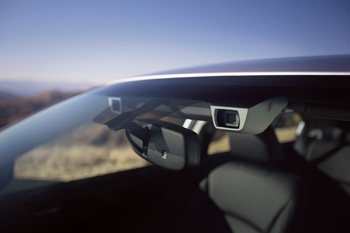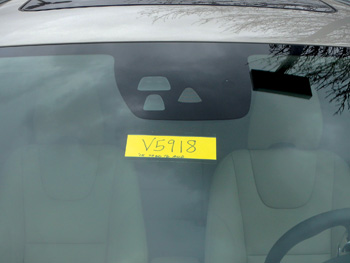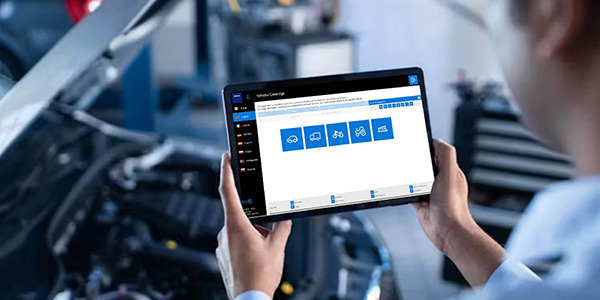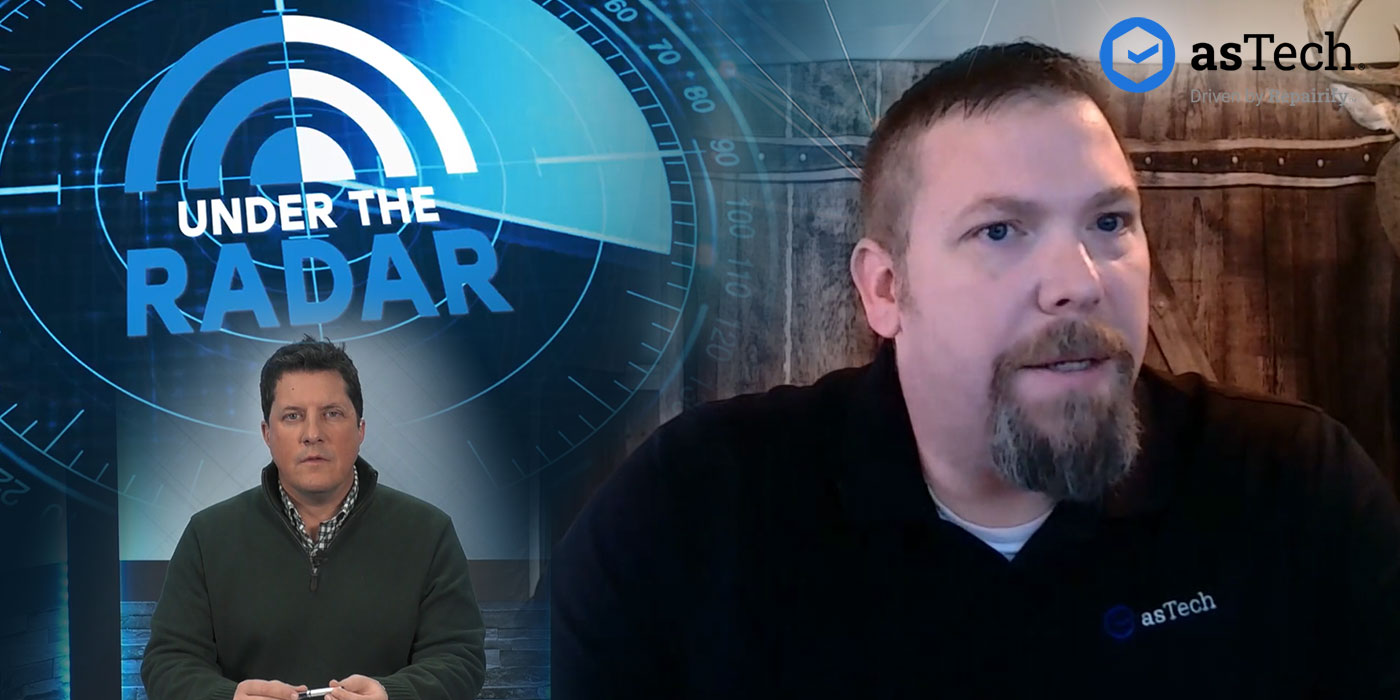
Part 1 of a three-part series. The next two installments will cover the vehicles this new technology addresses, and scan tools.
You have a customer’s car in your shop and you’re finishing up the repairs on the body. The paint looks good, the body looks good, so now let’s replace or install the windshield. You have the glass company come out, or maybe your shop is doing your own glass – either way, you have an issue. The vehicle is equipped with lane lock/lane change or other driver assist electronics that require a scan tool to complete the job. Are you seeing this?
Scan Tools
The need for scan tools to complete repairs in the collision industry is expanding. Scan tools have long been used to diagnose repair and reprogram computers in safety systems and electronics in drivetrains for years. We’re now seeing an increase in the use of scan tools to recalibrate sensors for the recent additions to the electronics packages in newer cars; for example, re-initializing programs after part replacement or sensor removal for repairs. The recalibrating of cameras after windshield replacements is just one of several procedures needed to be done before returning a vehicle back to service. As electronics and the use of specialized sensors become evermore present, so does the need to know how to repair and complete the job.
Glass Side
Like the auto body industry, change is happening to the auto glass side of the repair industry, too. The requirement to use scan tools to complete repairs is in all facets of the repair industry. We’ve all heard the grumble and groan of change in the industry, but the one thing we can be assured of is change in the automotive industry. And it’s never going to stop.
The questions you need to ask of your shop and yourself include:
- Are you ready for change?
- Do your people know how these systems work?
- Do you have the equipment you need?
- Are your people looking to see what needs to be done to complete
repairs?
Ready for Change?
New electronics being added to vehicles challenge repair companies to keep up or plan ahead. In the effort to make vehicles safer, car manufacturers are using new computers and sensors to aid in driving. Thus, the demand for information on how to repair these systems and to make sure they’re functional has increased. Recalibration is a term we’ll hear much about in the industry.
With the introduction of airbags, we learned that electronically, things were going to change. When occupant classification systems were added and improved, we knew we were in for more change. Using scan tools became a necessity, not a rarity, to repair the vehicle. The trend seems to be pushing for the same requirements and applies to other systems in vehicles as well.
How They Work
Autonomous driving systems seem to be all over the news. The thought of vehicles driving themselves amazes most people. Although it may be some time before the general consumer can use this technology, it’s being used in bits and pieces today. Between Volvo’s City Stop or Subaru’s Eyesight, we’re seeing a shift of electronics aiding drivers or taking control of vehicles.
Electronics in vehicles are becoming a complex combination of sensors, cameras and computers working together. The job of these computers and sensors is to assist drivers in their journey. Driver assist electronics either warn the driver of hazards or literally take control to complete or correct the situation. This assist is designed to do anything from reduce the effort needed to complete the task (in parking assist electronics) to reduce severity in crashes to save lives and cost.
Although the value of these electronics and their reliability is up for debate, the fact is they’re here and we need to understand how they work. The computer is not new to anyone, and the care and expertise to replace and repair a computer is a known factor. It works on a system of input and output. If A happens, then the computer module will respond with C. If A and B happen, then the module will respond with C and D.
This is a simple explanation of a complicated procedure. The module can only respond correctly if the sensors giving inputs are correct. If the input is wrong, then the output will be, too. All the sensors give a complex input to the computer, and the computer must know speed, angle and steering wheel position, among many other inputs. There can literally be hundreds of inputs from different systems working together. One failed or incorrect sensor can disable or cause the system to respond incorrectly.
Complex systems such as Volvo’s City Stop are designed to stop the vehicle if the driver is unaware of hazards in the roadway or does not respond to warnings being given by the vehicle. This system is basically designed to warn the driver, then actually take control and stop the vehicle with no input from the driver. The input comes from the driving systems, radar and lasers along with cameras to give the vehicle almost a self-awareness of its surroundings.
Adaptive cruise control is also available in many vehicle electronic packages. A radar and/or laser system will detect the vehicle in front of the vehicle it’s installed in. The system may lock on and literally pace the vehicle in front, maintaining a safe distance and matching variations in speed.
Lane lock and lane change systems do as they say. If a vehicle is leaving its lane and no turn signal has been activated, the vehicle will give the driver a warning. In some packages, the vehicle may actually apply pressure to the steering wheel or apply the brakes to gently center the car back into the lane.
I could fill this entire magazine with the differences and capabilities of the systems being offered by vehicle manufacturers. The point is, do you know how they work? Do you know what’s needed to repair if damaged or removed to access other damaged areas? What needs to be done to activate or recalibrate the system? In many of the systems above and more to come, a scan tool may be needed to finish the repair. And there will not be a light on the dash to tell you; instead, it will be in the instructions for repair. Also be aware that not all vehicle manufacturers require a scan tool to complete repairs; some are self diagnostic.
What You Need
There really is no such thing as a simple repair anymore. Even the task of replacing a windshield is becoming specialized. Identifying the needs to complete the job is the first step to the procedure.
When a vehicle is set up to be repaired for body work or a windshield replacement, look into the options available. If the repairs require the removal or replacement of items that contain or are used in conjunction with any sensors, you will have to look up the procedures required to repair these components. An example would be the mirror removal on a door equipped with a blind spot monitoring system. The procedure may call for a recalibration to be sure all sensors are functional. Looking into the P-pages, OE information providers or vehicle manufacturer websites becomes a requirement, not an option. How can a repair be completed correctly if you don’t access the instructions?
 Drivers Assist
Drivers Assist
The basis of this article comes from a simple procedure of replacing a windshield in vehicles equipped with driver assist systems such as lane lock/lane change from Honda and Subaru’s Eyesight that use cameras or lasers focusing through the windshields. In these replacements, we’re finding that a scan tool is required by some vehicle manufacturers to recalibrate cameras and/or other optical devices. Honda, Subaru and Volvo are just a few on a growing list that require scan tool procedures if the vehicle is so equipped. This creates a dilemma for the auto glass industry, as these technicians do not have and/or haven’t used scan tools before. Each vehicle manufacturer has a different requirement for scan tools, and there is no single tool out there that does it all.
This refuels the debate on which scan tools a shop should buy. Is the one you’re looking at capable of these advanced functions? Do you buy a tool for Ford and one for GM? Do you need another one for Honda, then another for Toyota? This list goes on and gets expensive.
Sending a car to the dealer also creates problems due to cycle time being affected. I hate to say this, but it also begs the question: Is the dealer trained or prepared for this? Does the technician have the training or ability to use the tool correctly? Can I use aftermarket glass, or does it have to be dealer glass? Does the dealer know how to calibrate the system to use aftermarket glass? These problems are already causing huge headaches in the auto glass industry. The fact is that there is no one tool currently that does it all in the scan tool world.
In almost all these systems, the driver can override or shut off the feature. This has fueled a debate as to whether these systems are required to be functional before returning the vehicle back to service. The systems themselves have limitations as to the environments they work in.
For example, you’ve just replaced a windshield in a new Honda, and you need to recalibrate the camera for the new windshield. You do not have a scan tool capable of doing this, and the dealer is either 100 miles away or is not able to do this procedure for you for three days. What do you do? Do you shut off the system until the repair can be completed and prevent the owner from using the system they paid for? Do you hold the vehicle until the repairs can be completed and reduce your liability? Remember, this sensor is connected to other required safety systems. Now, a safety device has been rendered inoperative by not completing repairs you were assigned to do or were hired to complete. Where does this place your liability? Either way, the customer is not happy. These features are not required safety features yet, but they are safety features.
Planning
I wish I had a miracle answer to the dilemma as I myself struggle to find answers for my shop. I’ve found that the research is so new, there isn’t much to use as a reference. In Europe – where these driver assist systems are mandatory – scan tool companies are stepping up to do multiple lines. I’m looking into these now and will write an article on what I find soon.
I currently believe that planning ahead is a start. Look up options in vehicles, and look up the instructions to repair. If a scan tool is needed to complete the repair, explain this to the customer up front. Let them know what needs to be done, and that extra time may be needed. Schedule repairs and coordinate with whomever has the scan tool. Remember that it isn’t just the dealers that have these scan tools. Coordinate your time wisely. I personally feel that delivering a vehicle with incomplete repairs back to the consumer is not an option.













